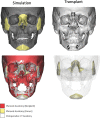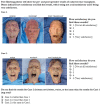Feasibility and Perception of Cross-sex Face Transplantation to Expand the Donor Pool
- PMID: 33133951
- PMCID: PMC7544392
- DOI: 10.1097/GOX.0000000000003100
Feasibility and Perception of Cross-sex Face Transplantation to Expand the Donor Pool
Abstract
Background: A major challenge in face transplantation (FT) is the limited donor allograft pool. This study aimed to investigate the feasibility of cross-sex FT (CSFT) for donor pool expansion by: (1) comparing craniomaxillofacial metrics following CSFT versus same-sex FT (SSFT); and (2) evaluating the public and medical professionals' perception of CSFT.
Methods: Seven cadaveric FTs were performed, resulting in both CSFT and SSFT. Precision of bony and soft tissue inset was evaluated by comparing pre- versus post-operative cephalometric and anthropometric measurements. Fidelity of the FT compared to the virtual plan was assessed by imaging overlay techniques. Surveys were administered to medical professionals, medical students, and general population to evaluate opinions regarding CSFT.
Results: Five CSFTs and 2 SSFTs were performed. Comparison of recipients versus post-transplant outcomes showed that only the bigonial and medial intercanthal distances were statistically different between CSFT and SSFT (P = 0.012 and P = 0.010, respectively). Of the 213 survey participants, more were willing to donate for and undergo SSFT, compared with CSFT (donate: 59.6% versus 53.0%, P = 0.001; receive: 79.5% versus 52.3%, P < 0.001). If supported by research, willingness to receive a CSFT significantly increased to 65.6% (P < 0.001). On non-blinded and blinded assessments, 62.9% and 79% of responses rated the CSFT superior or equal to SSFT, respectively.
Conclusions: Our study demonstrates similar anthropometric and cephalometric outcomes for CSFT and SSFT. Participants were more reticent to undergo CSFT, with increased willingness if supported by research. CSFT may represent a viable option for expansion of the donor pool in future patients prepared to undergo transplantation.
Copyright © 2020 The Authors. Published by Wolters Kluwer Health, Inc. on behalf of The American Society of Plastic Surgeons.
Conflict of interest statement
Disclosure: Dr. Rodriguez has received speaker honoraria for unrelated activities from DePuy Synthes CMF and KLS Martin. All the other authors have no financial interest to declare. This work was supported by the Office of Naval Research (Grant N00014-10-1-0868), the US Department of Defense—Congressionally Directed Medical Research Programs (under Reconstructive Transplant Research Award W81XWH15-2-0036), and New York University Langone Health.
Figures







Similar articles
-
Public Perceptions of Cross-Sex Vascularized Composite Allotransplantation.Ann Plast Surg. 2020 Dec;85(6):685-690. doi: 10.1097/SAP.0000000000002472. Ann Plast Surg. 2020. PMID: 32694461
-
The Public Face of Transplantation: The Potential of Education to Expand the Face Donor Pool.Plast Reconstr Surg. 2018 Jan;141(1):176-185. doi: 10.1097/PRS.0000000000003954. Plast Reconstr Surg. 2018. PMID: 29280879
-
Adequacy of spine surgery fellowship training in Turkey: Results of a survey.Acta Orthop Traumatol Turc. 2022 Jan;56(1):71-75. doi: 10.5152/j.aott.2022.21211. Acta Orthop Traumatol Turc. 2022. PMID: 35234133
-
Weight loss interventions in living donor liver transplantation as a tool in expanding the donor pool: A systematic review and meta-analysis.World J Gastroenterol. 2021 Jun 28;27(24):3682-3692. doi: 10.3748/wjg.v27.i24.3682. World J Gastroenterol. 2021. PMID: 34239278 Free PMC article.
-
To transplant or not to transplant recurrent hepatitis C and liver failure.Clin Liver Dis. 2003 Aug;7(3):615-29. doi: 10.1016/s1089-3261(03)00053-9. Clin Liver Dis. 2003. PMID: 14509530 Review.
Cited by
-
Trends, Gaps, and Collaboration in Facial Transplantation: A Bibliometric Study.Plast Reconstr Surg Glob Open. 2022 Apr 15;10(4):e4248. doi: 10.1097/GOX.0000000000004248. eCollection 2022 Apr. Plast Reconstr Surg Glob Open. 2022. PMID: 37073383 Free PMC article.
-
The 2020 Facial Transplantation Update: A 15-Year Compendium.Plast Reconstr Surg Glob Open. 2021 May 21;9(5):e3586. doi: 10.1097/GOX.0000000000003586. eCollection 2021 May. Plast Reconstr Surg Glob Open. 2021. PMID: 34036025 Free PMC article.
-
Face Transplant: Indications, Outcomes, and Ethical Issues-Where Do We Stand?J Clin Med. 2022 Sep 28;11(19):5750. doi: 10.3390/jcm11195750. J Clin Med. 2022. PMID: 36233619 Free PMC article. Review.
References
-
- Maciejewski A, Krakowczyk Ł, Szymczyk C, et al. The first immediate face transplant in the world. Ann Surg. 2016;263:e36. - PubMed
-
- Barret JP, Gavaldà J, Bueno J, et al. Full face transplant: the first case report. Ann Surg. 2011;254:252–256. - PubMed
-
- Guo S, Han Y, Zhang X, et al. Human facial allotransplantation: a 2-year follow-up study. Lancet. 2008;372:631–638. - PubMed
-
- CNN. Man’s second face transplant is a world first. 2018. Available at https://www.cnn.com/2018/04/17/health/second-face-transplant-bn/index.html. Accessed March 1, 2020.
-
- TIME. He’s the First African American to Receive a Face Transplant. His Story Could Change Health Care. 2019. Available at https://time.com/5709294/first-african-american-face-transplant/. Accessed March 1, 2020.
LinkOut - more resources
Full Text Sources
